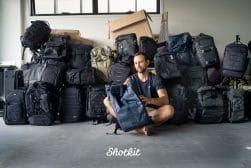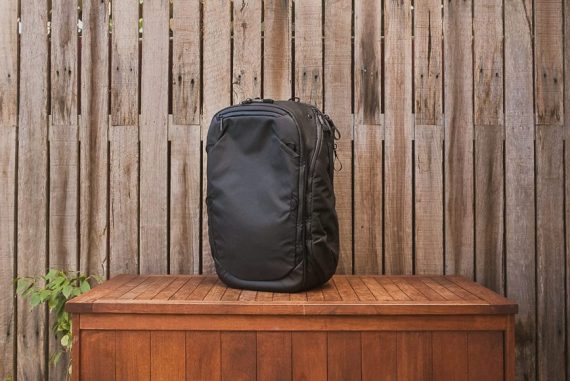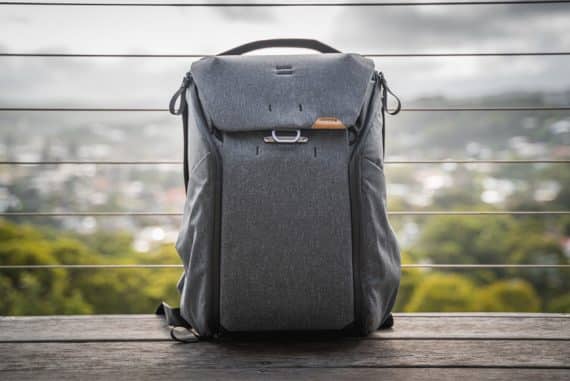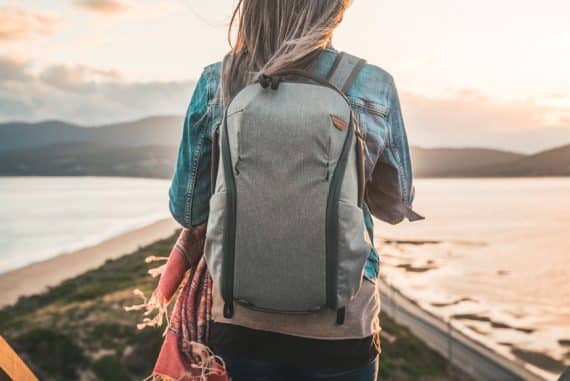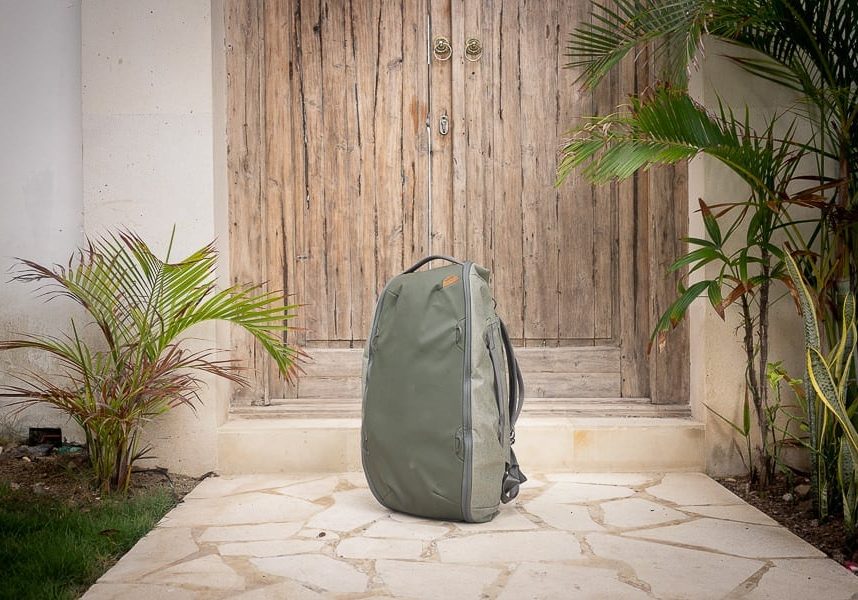
Peak Design 65L Travel Duffelpack Review
The Peak Design Travel Duffelpack surprised me in becoming my one-bag travel solution for my camera gear. It's also the most comfortable backpack I've used!
A duffel bag isn’t usually a photographer’s first choice when it comes to selecting from the myriad of options available to carry camera gear.
You probably associate a duffel bag with going to the gym, or as an ‘overnight bag’ for a weekend away.
Up until recently, I used a combination of a regular backpack and a rolling camera bag when shooting destination weddings. Neither bag was quite big enough to cram everything into just one piece of carry on luggage… which was always my goal.
Enter the Peak Design Travel Duffelbag – a 65L behemoth of a gear-hauler from the guys behind the Everyday Backpack, and so many other successful carry-products.
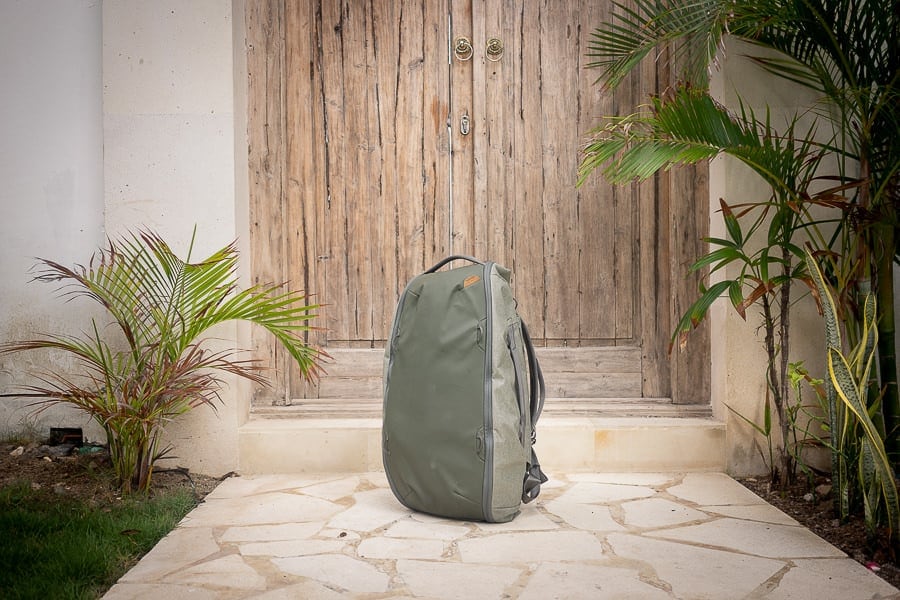
Elegant and ergonomic, this 65L duffel-backpack lets you carry all your gear and then some.
Would this duffel-bag-cum-backpack really be able to fulfill my solo-travel-bag needs here in 2024? Let’s dive in to the review!
Peak Design Travel Duffelpack 65L Specs
- Looks (especially the Sage colourway)
- Weight – empty, it’s among Peak Design’s lightest bags
- Size (45L is perfect – 65L is useful for unforeseen circumstances)
- More comfortable as a backpack that you’d expect
- So easy to get your gear in and out quickly
- Side/top/bottom handles are great for overhead compartments
- Internal zippers can cause scratching
- Can be too big for smaller frames
- Materials: Exterior fabric is weatherproof, 100% recycled 600D nylon canvas. 900D Ottoman-weave Poly bottom fabric. Woven nylon straps with Hypalon. Nubuck leather accents only on Sage. Silicone-coated mesh internal pockets.
- Capacity: 45L min, 65L max. Peak Design Packing Cube capacity: 4 units
- Weight (Empty) 1.77 kg (3.9 lb)
- External Dimensions: Standard: 66cm x 38 cm x 30cm (26″ x 15″ x 12″) Circumference: 110cm (43″) Expanded: 66cm x 42 cm x 34cm (26″ x 17″ x 13″) Circumference: 134cm (53″)
- Internal Dimensions: Standard: 26in (66cm) x 9.5in (24cm) x 9in (23cm). Expanded: 26in (66cm) x 15in (38cm) x 9in (23cm)
Build & Appearance
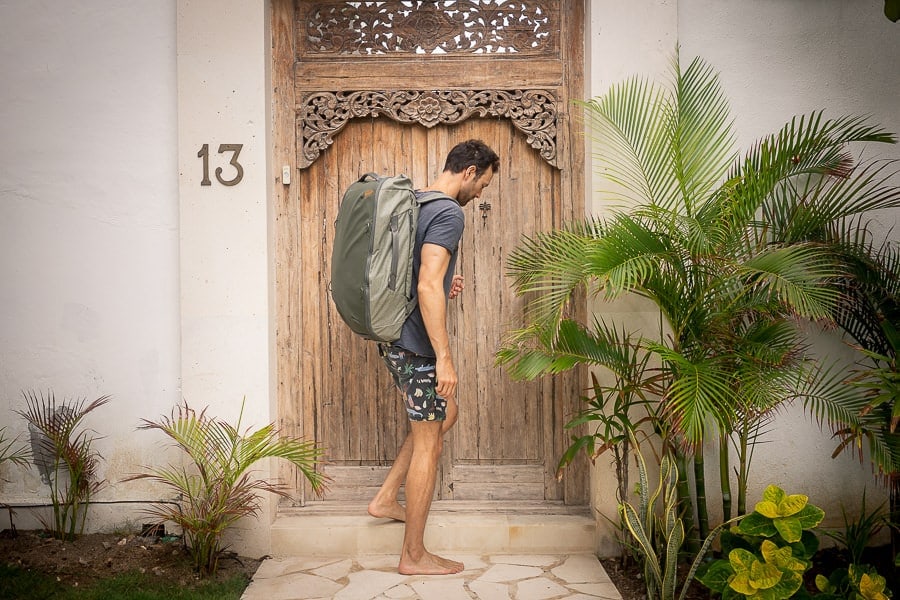
The Duffelpack looks unlike any other backpack you’ll come across.
Peak Design seem to have taken a leaf out of Apple’s less-is-more approach to design of late.
The extremely popular Peak Design Everyday Backpack had a little too much going on for my personal tastes, whereas the recent additions to the Travel line (notably the Peak Design Travel backpack), are more minimal in external design.
The Travel Duffelpack reminds me of an origami spring roll, with various folds in the fabric giving it a modern, technical twist.
I’ve always chosen black when it comes to bags, but this time I took a punt on the ‘sage’ version, which is closer to grey than green, and unlike any other bag colour I’ve seen – it really is unique, and I really like it.
The base of the bag (which becomes the ‘back’ when in backpack mode) is made from something called ‘Ottoman-weave Poly’, which is slightly glossy, and offsets the matt fabric of the rest of the bag. It’s also weatherproof.
As for build quality, the Peak Design Travel Duffelpack is a premium product which is built to last a lifetime – in fact, as with all Peak products, it’s got a life-time warranty.
Zippers slide effortlessly, handles are sturdy, stitching is perfect, padding is comfortable – this is a bag that’s able to take all the abuse you throw at it, and still look great carried on your back or by your side.
Exterior Features
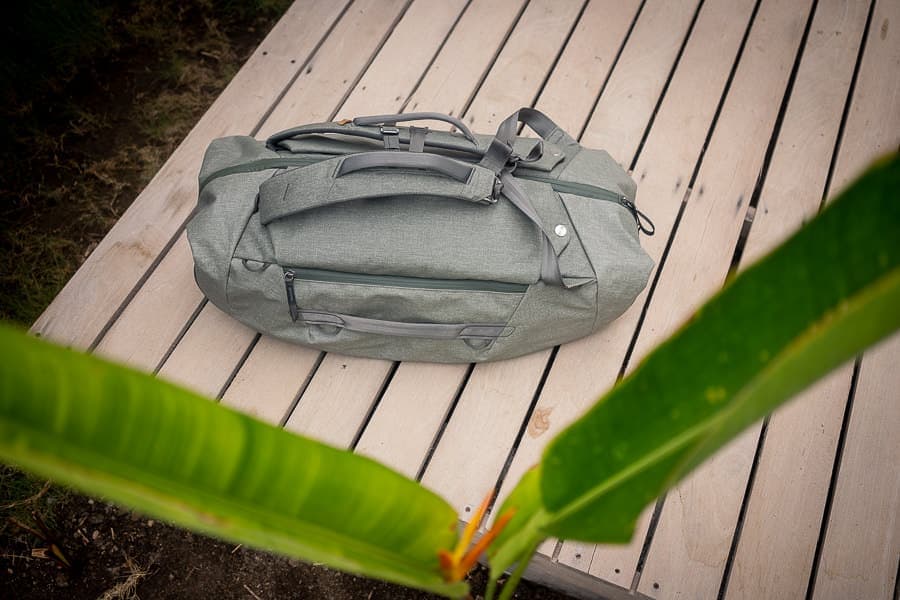
A premium duffel bag that’s been designed to be carried as a backpack.
Part duffel bag, part backpack, the Peak Design Travel Duffelpack is a rather unique way to carry your camera gear, clothes, and whatever else you can stuff in its gargantuan 65L capacity.
In fact, the Travel Duffelpack is ‘only’ 45L in its normal state – the additional 20L reveals itself when you unzip the two zips on the undersides of the bag.
If the contents of your Duffelpack are soft enough, you can actually use these expansion zippers as a form of compression – simply open the zippers to expand the bag to its full 65L capacity, stuff as much gear as you can inside, then close all the zips back up.
Peak Design want you to use their ‘packing tools’, which is advisable since they keep all your gear so neat and tidy inside.
As for safely transporting your camera gear, there are 3 sizes of camera cube that can fit nicely inside the Duffelpack.
To maximise space, I prefer to use the 5L Peak Design Sling (reviewed here) as a ‘packing cube’ of sorts – this way you have a smaller every-day-carry bag ready to deploy.
There are two large zippers that run across the sides of the Duffelpack, which open to reveal handy pockets, for iPads, passports, headphones, water bottles and the like.
There’s also a neat little ID card slot, which is almost too well concealed to be noticed by anyone who happens to come across your bag when missing.
The padded ‘flaps’ on the top of the Peak Design Travel Duffelpack is where the magic happens. Behind them, lie two padded waist straps, which can be released with a quick slide, before you put the bag on your back.
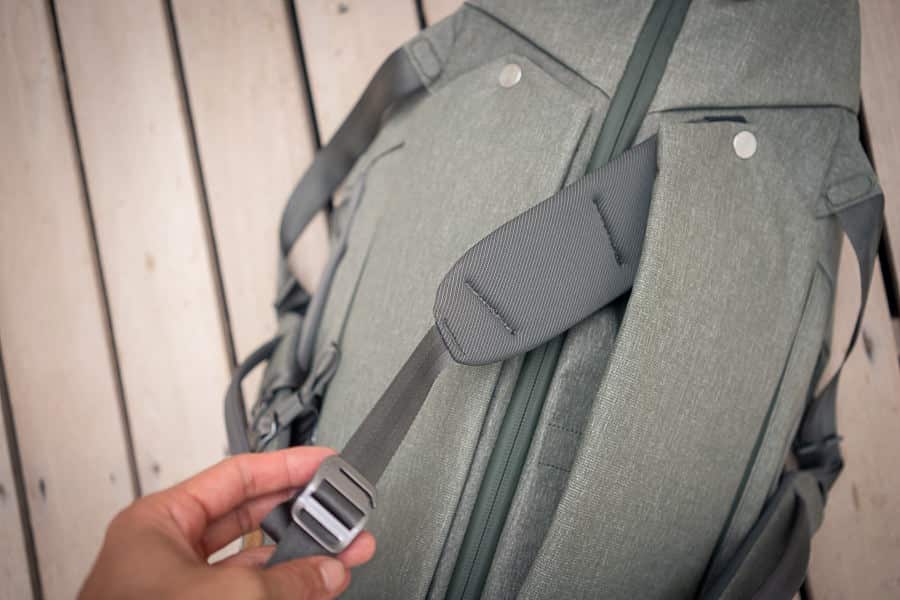
The padded back flaps neatly conceal hip straps.
While you may not ever need to use the hip straps, they act as additional ‘buffers’, increasing the already-decent padding on your back when carrying the Duffelpack in backpack mode.
The shoulder straps feature an adjustable sternum strap, and two hefty grab handles, which are intended to be used when carrying the bag in duffel mode.
I have to admit, I rarely used the Travel Duffelpack in duffel mode. The grab handles did prove useful once or twice when quickly grabbing the bag off the floor, but the majority of time I used it as a travel backpack.
Since its name suggests that you should carry the Duffelpack as a duffel bag (i.e. in one hand at your side), I was pleasantly surprised at how well it functioned as a backpack. I actually found it more comfortable than most other dedicated backpacks.
This could be to do with my height (6ft 4″), or the length of my upper torsos, but whatever the case, it’s an awesome backpack – comfortable, easy to get on and off, and impressively durable.
Another highlight of the Duffelpack and what makes it so functional to use as a camera gear hauler is the extra long main zipper, which allows the entire bag to hinge open, much like a doctor’s bag.
This small design detail makes it infinitely easier to add or remove items to the bag, and makes accessing your camera gear a breeze.
The Peak Design Travel Duffelpack is actually a cross between a duffel bag, a backpack… and a traditional rolling camera bag, in the way that it can open completely to reveal the entirety of your gear. Accessing your camera gear with the bag laid out completely on the ground just makes sense.
Interior Features

The simple, cavernous interior is best used with packing cubes.
In stark contrast to the Peak Design Travel Backpack, which was a confusing melange of every storage option imaginable, the interior of the Travel Duffelpack is thankfully much simpler.
Two zippered mesh side pockets offer internal stitching to separate them into 4 separate compartments, ideal for lens filters, cables, batteries, and other smaller items.
There’s no official laptop sleeve, but due to to the cavernous dimensions of the Duffelpack, it’s not hard to find a spot for one.
I made the mistake of stashing my Macbook Pro at the front of the bag (i.e. closest to my back when wearing it as a backpack). This made sense from an accessibility point of view, but due to the metal internal zippers, the laptop lid suffered some unfortunate scratches.

Internal zippered pockets are useful but can scratch.
This could have been alleviated by ‘covering’ the zipper pulls when in the closed position using a piece of material, which is common practice with Think Tank Photo bags, among others.
I chose instead to sandwich my laptop in between some items of clothing, protecting it from those nasty zippers…
Storage Capacity

One week in Bali to shoot a destination wedding – 45L worth of gear.
My travel backpack size of choice has always been 45L, which is usually in keeping with carry-on luggage regulations.
Having the additional 20 litre capacity available on the Peak Design Travel Duffelpack is incredibly useful.
45L is more than enough to house my entire camera gear arsenal needed to shoot a destination wedding, alongside enough clothes to last a week in a hot country.
Then, if I decide to do some shopping, I can expand the Duffelpack by 20L, and either try and sneak it back on as carry-on luggage, or check the bag in, safe in the knowledge that it’ll come out the other end unscathed.
Ease of Use/Comfort
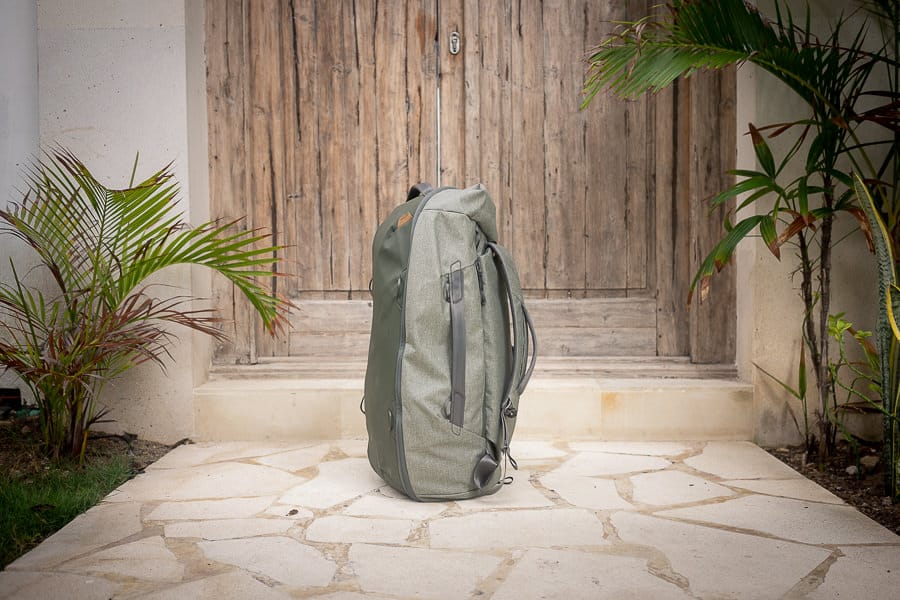
Straps are on the sides, top and front of the Duffelpack.
Getting gear in and out of the Peak Design Travel Duffelpack is simple and enjoyable. Being able to open the smooth-sliding zippers to reveal the entirety of the contents of your bag is a revelation.
It also means that whatever camera cube you choose to house your camera gear will be completely revealed – even if stowed at the very ends of the bag.
The best part about carrying the Duffelpack as a backpack is when you actually come to take it off your back – instead of placing the strap side down (like you would a traditional backpack), the straps remain on the top of the bag.
This slight change in usage actually makes a huge difference. Not only is it much easier and faster to slide a heavy bag off your back onto the ground without ‘twisting’ it the other way up, it also makes perfect sense from a cleanliness perspective – the part of the bag that meets your back always remains clean!
The more I used the Peak Design Travel Duffelpack as a backpack, the more I appreciated this. It makes me wonder why no backpack has been made which opens in this unique way too.
When not carrying the Duffelpack as a duffel or a backpack, it’s nice to be able to quickly grab it using either one of the side handles, or those found at the top and bottom of the bag – these were especially useful when pulling the bag out of overhead luggage compartments.
Value for Money + Discount Code
Peak Design products are premium-priced for people who appreciate premium quality and design.
At around $220, the Travel Duffelpack thankfully isn’t priced out of reach for most photographers or frequent travelers.
Since it can easily replace both a backpack and a travel bag, it’s actually great value for money, and makes for a sound investment if you plan to use it like I do, transporting camera gear safely as well as clothes and other travel-related knick-knacks.
Peak Design Travel Duffelpack Review | Conclusion
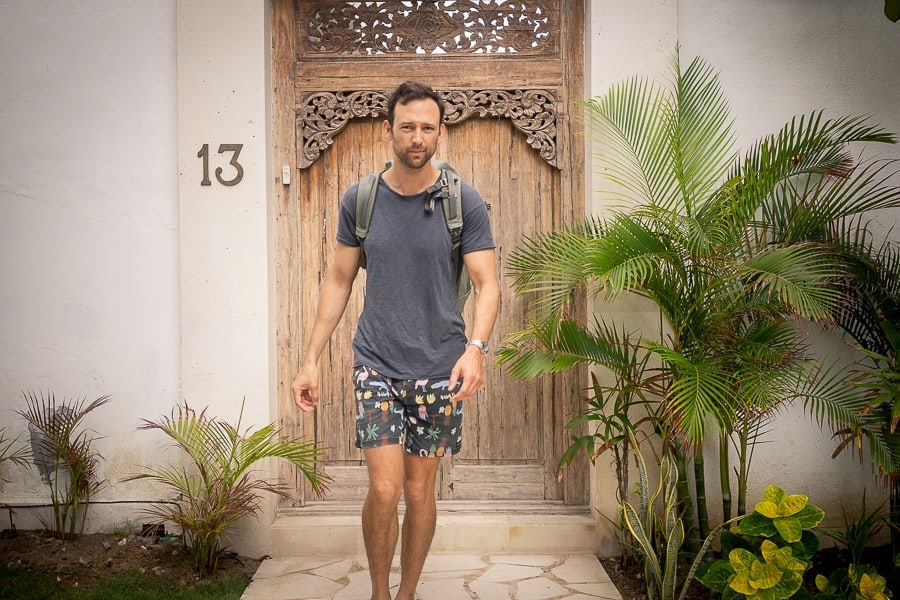
The Duffelpack was my gear hauler of choice for 2024.
When testing the Duffelpack on my overseas trip to Bali this year, I never expected for it to become my main travel camera bag of choice.
I fell in love with its unique design, looks and functionality, and am pleased that it can effectively replace two of my most commonly used travel bags.
Sure, it’s not meant to be a dedicated camera bag, and the lack of dedicated internal pockets may deter some O.C.D. photographers, but for everyone else, this bag has everything you need and nothing superfluous.
It’s understated enough to pass through foreign streets unnoticed, while still remaining stylish and functional. Just be careful of those damn zippers!

Elegant and ergonomic, this 65L duffel-backpack lets you carry all your gear and then some.





